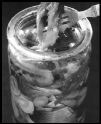Someone at a party recently told me that the world’s finest—and most expensive—coffee is made of beans which are eaten and then, uh, excreted by some kind of bird. Is this so? What kind of bird? Is it a very jittery bird? And who thought to grind up dried bird poop and put it in a cup with boiling water in the first place?
Deb Broderson
Ah, the legendary stercoricolous coffee of Indonesia. Your friend is referring to the notorious Kopi Luak, which is indeed (at least according to those who charge hundreds of dollars a pound for it) harvested from animal feces. However, it is not a bird (or a plane), but a relative of the mongoose called the palm civet (or luak), whose droppings are culled for these nuggets of black gold.
Oh, and now I suppose you’ll want to know what thrill-seeking java junkie, twisted by addiction and lack of sleep, had the brain wave of turning to mongoose dung in his desperate, caffeine-fueled search for some new kind of kick. As if it weren’t obvious. You people.
Here’s the rationale: According to local legend, the palm civet, in spite of its categorization as an omnivore, is a fastidiously picky eater. Thus, it is thought that this musky epicure selects only the coffee cherries that are at their very peak of ripeness and savor. (Other foodstuffs selected by the civet at their very peak of ripeness and savor include: insects, palm sap, birds, voles, spiders, squirrels, and frogs.)
As the civet’s gustatory interest is strictly in the outer, pulpy portion of the coffee fruit, it allows the commercially viable pit (containing two of what we know as the coffee bean), to pass through its digestive tract physically unscathed, though perhaps somewhat morally cheapened.
Like the common house cat, the civet habitually tends to void its bowels in the same spot every day. Thus, it’s the work of but a moment for cheerful coffee plantation workers to run their fingers through the creature’s rich, loamy feces and glean the treasures within, which are then washed (thank god for small comforts), roasted, and sold as “the world’s finest, and most expensive, coffee,” at prices often exceeding $200 per pound.
What inquiring minds want to know, of course, is whether the civet’s preternatural skill in the area of bean selection is really valuable enough to offset the unorthodox manner in which it chooses to package its product. I mean, I could be a gourmand of the highest order, with impeccable taste in food, dining only on the finest filet mignon, truffles, caviar, etc. However, were I to attempt to serve you a steaming salver of my bodily wastes—perhaps responding to your expression of disgust with a defensive, “What? It was delicious when I ate it”—you could be forgiven for being unimpressed.
I have not had the good fortune to cup this brew, but the word “gamy” keeps cropping up in the literature, as well as the term “musky.” Civets do have musk glands, and the secretions of some species are harvested for use in the manufacture of perfumes, so it’s possible the catlike creature’s butt juice does impart some je ne sais quoi to the finished product. But most coffee pros suspect that it’s Kopi Luak’s scarceness and novelty, rather than its quality, which drives its price.
The locals on Anderson Island claim that the two lakes on the island are fed by runoff from Mount Rainier. Is it really possible that water could travel under Puget Sound to the island? We asked my wife’s uncle about this—he’s a geologist. He was highly suspect but wouldn’t say it’s impossible.
Matt Love
Your wife’s uncle the geologist is indeed highly suspect. If I were you, I would march over to his house right now and ask to see his diploma—or perhaps skip that embarrassing formality entirely and just ask him point-blank who he rolled over on to qualify for the federal witness protection program, because a real geologist would know that water can travel for quite long distances through the Earth’s crust, and at far greater depths than those of the relatively shallow Puget Sound. (A real geologist also probably wouldn’t wear that pinky ring or tool around in that bulletproof Bentley you’ve always wondered about). Iceland has spring-fed lakes, and it’s a good deal further removed, and by far deeper water, from the nearest major landmass.
The Earth’s crust is the Earth’s crust. Once you get below its surface, it doesn’t really give a damn whether it’s supporting land, water, or luxury condominiums. (This is why you don’t need a submarine to drive through the Lincoln Tunnel.) If sea level happened to be 900 feet lower, the bed of what is now the Sound would be dry land, and you wouldn’t find it even slightly puzzling that there were spring-fed lakes on Anderson Hill.
In sum: If water can travel under ground that has trees and buildings on it, it can travel under ground that has standing water on it. The aquifers don’t know or care what’s overhead.
Wondering why Dick Cheney is still stuffing his face with red meat and bacon, even after all those heart attacks? Write the Askmaster at askmaster@seattleweekly.com or 1008 Western Ave., Suite 300, Seattle, WA, 98105.









